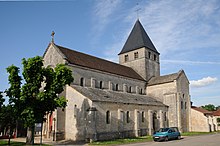St-Florent-St-Honoré (Til-Châtel)
The Romanesque-early Gothic church from the 12th century, consecrated to Saints St. Florent and St. Honoré , is the Catholic parish church of the municipality of Til-Châtel in the Côte-d'Or department in the Bourgogne-Franche-Comté region . The church is located in the upper (western) district on a street parallel to the thoroughfare towards Is-sur-Tille .
history
Til-Châtel became famous as one of the capitals of Lingons and was one of the military bases in the Roman Empire on the road from Chalon-sur-Saône to Langres built by Agrippa .
In this area, the geographical crossroads of Europe, Til-Châtel saw the invasion of barbarians for over five centuries, from Attilas Huns to the Hungarians in 937. Feudalism developed in the Middle Ages and with it are the castle and the Church emerged as the pillars of this society. From this era on, the lords of Til-Châtel held a rank that came just behind the dukes of Burgundy between Dijon and Langres. In 1116 a solemn church convention took place in the open air in Til-Châtel (Val d'Ogne), chaired by Guy, Archbishop of Vienne. He was made pope in 1119 ( Calixt II ). Saint Bernard assisted him.
Historians report for the first time about the church of Til-Châtel, referring to an act of donation from a monseigneur Betto, Bishop of Langres, to the monks of St. Etienne in Dijon in 801. After 1033 a canon chapter was established under the leadership of a prior. The ruins of this building were to the north of the transept . They were demolished in 1971.
According to legend, the Christian governor Saint Florent was martyred by barbaric vandals around 407-408. They wanted to force him to worship idols. Since he refused, he was tied to bicycles and dragged to the bridge that leads over the Tille. Then he was beheaded with a ploughshare over the edge of the well. Stones from the bridge were used to build today's altar.
The church has been considered a monument since the 19th century. It was built in the 12th century, important repairs were carried out in the 13th century, and in 1620 an inscription was placed over the main portal that reads: "Cette eglise a ete rehaussee - 1620" (This church was enlarged in 1620 been).
Church cartridge
The church is dedicated to St. Florent and St. Honoré. The building in its present form goes back to Pope Kalixt II. The church was consecrated in 1495.
The second church patron, Saint Honoré, is also the subject of legend. During the earthworks in the cemetery of the monastery, a worker allegedly stole a thigh bone from a coffin and behaved inappropriately. As a result, his arm was paralyzed. The bishop of Langres decided to put the coffin with the bones in the church and during the transfer a child shouted “O Sancte Honorate”, which then became Saint Honoré. The worker was cured of his paralysis and since then the belief in miracles has grown up around the new saint. The reliquaries are an expression of these events.
architecture
The style is Romanesque, the floor plan depicts a cross with the tip facing west. The axis of the entire complex is inclined slightly to the southwest. The choir and the side chapels are rounded. The vault over the apse and the side apses is a semi-domed vault.
The church opens to the west through a very beautiful portal: on the baptismal font Christ is depicted in his majesty, surrounded by the symbols of the four evangelists. The vaults are separated by cords of hewn stone that fall on the round pillars, the most notable of which is the trunk of a palm tree. The side door in the south is similar to that of the main portal. The square church tower houses two bells that were cast in 1763 and 1820. Columns with ornate capitals (bear's claw leaves, palmettes, fantastic animals and people) run along the main nave.
Furnishing
On the left there is a cloister between two columns. The figures are carved from wood and come from an Italian school (17th century).
At the entrance to the choir, on the left, there is a wooden triptych donated by Jean Morelot and his wife on the occasion of their wedding in 1610. In the center Christ, on the right the donor and his patron, on the left the donor and Saint Yves. Her motto: "Un seul sentier West cloz à la vertu" (Only one path leads to salvation).
After the gilded shrine of St. Florent, which stands on a stone ledge, we find the stone altar in the heart of the choir, which was originally only intended as a pedestal for a wooden altar, the work of a Langre resident carpenter and stonemason from 1790. The altar is currently in the Museum of Sacred Art in Dijon.
In the south aisle a baptismal font from the 9th century and the altar of Saint Honore on a sarcophagus. In front of it is a painted wood shrine from the 16th century (10). The old, dismantled pulpit, which was installed in October 1726, can also be found here. Further back, on the left, a mocked wooden Christ from the 12th century. Faded frescoes from the 15th century can still be seen on one side of the altar of the Holy Sacrament, on the main altar, on the transept and on some columns.
Many tombstones of the lords of Til-Châtel and other people who built this land, such as priests, junkers, councilors, bailiffs, are set up along the walls or at ground level and overgrown with plants.
See also
- List of Romanesque monasteries, churches and chapels in Côte-d'Or (Burgundy)
- List of churches and monasteries in Burgundy
Web links
- St-Florent-et-St-Honoré (Til-Châtel) in the Base Mérimée of the French Ministry of Culture (French)
Coordinates: 47 ° 31 ′ 5.2 ″ N , 5 ° 10 ′ 19 ″ E





